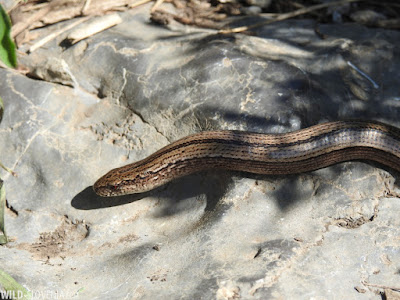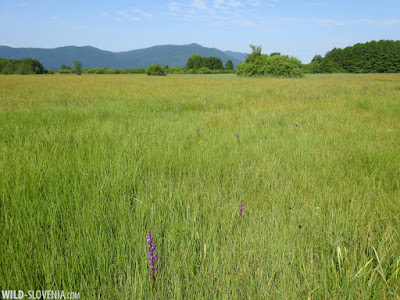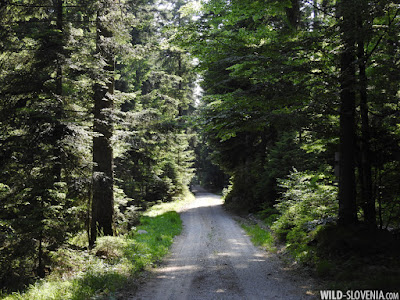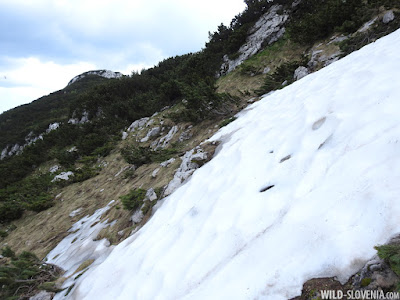Despite summer approaching fast, mid June is still an excellent time for wildlife watching, especially in the cooler areas of continental/mountain Slovenia. In the past week we spent some days in the fabulous Notranjska region, in our opinion the wildlife hot-spot of the whole country! It wasn't a particularly intense week, but still, we interspersed activities such as canoeing on Cerkniško jezero (lake Cerknica) with hiking on mount Snežnik and the likes. As usual, we managed to gather a considerable amount of photos of all the various wildlife we encountered and therefore here will follow an extremely long (!) photo selection, arranged more or less in chronological order. We hope you enjoy this insight into the wildlife of Notranjska!
For a good start we wanted to check on the progress of "our" nesting Black Storks Ciconia nigra (the only known nest in western Slovenia). We were therefore very excited to see that a large chick was in the nest. It already had some wing feathers, but most of the body was still covered in down. It must have hatched several weeks ago. This pair only has one chick probably because of the old age of the adults, which have been known to nest in the area for over 15 years. We only spent 10 minutes at the site, took a few photos with our powerful superzoom cameras and left, in order not to disturb the birds too much. Nearby, in a muddy puddle in the middle of the forest, we found some nice Yellow-bellied Toads Bombina variegata along with some well-developed tadpoles of Common Frog Rana temporaria. Even more exciting was the find of an interesting fungus - Chicken of the woods Laetiporus sulphureus.
 |
| Black Stork Ciconia nigra - adult with chick on the nest. |
 |
Yellow-bellied Toad Bombina variegata
|
 |
Such forest puddles with shallow water are the perfect habitat for Yellow-bellied Toad.
|
 |
Chicken of the woods Laetiporus sulphureus
|
 |
Common Stinkhorn Phallus impudicus
|
Next we wanted to check a location on the Snežnik plateau where a few plants of the rare and beautiful Lady's Slipper Cypripedium calceolus grow. The site has been known among botanists and amateaurs for about 7 years and we first went to see these plants back in 2015. At the time there were only a few specimens, while this year we counted 13 flowering stems, plus several other leaves of plants not in flower. This seems to be the only known locality of Lady's Slipper on Snežnik and in this part of Slovenia, while the species occurs much more abundantly in the alpine region, especially in some alpine valleys in the north. Nearby there were also several other interesting plants, among which the highlight were some tiny Coralroot Orchids Corallorhiza trifida, another species you don't see commonly outside of the Alps.
 |
Veliki Snežnik (1796 m) and the forests on its plateau.
|
 |
Lady's Slipper Cypripedium calceolus
|
 |
Selfie with rare flowers.
|
 |
Coralroot Orchid Corallorhiza trifida
|
 |
White Helleborine Cephalanthera damasonium
|
 |
May Lily Maianthemum bifolium
|
During the week, while driving in the dinaric forests of the Javorniki mountains, we regularly came across families of
Ural Owls Strix uralensis. We flushed one such family from the trees by the side of the road and were amazed to count at least four fledged juveniles. We didn't actually see the adults (which were certainly nearby), but the "flock" of young Ural Owls itself was already enough to catch our attention. The owls were also quite loud, vocalising very similarly to young/female Tawny Owls
Strix aluco. On one occasion, whilst driving with an open window, we located two juveniles only thanks to their loud calls. As it was expected, this year's "vole year" is resulting very productive for the breeding of forest owls (including Ural, Tawny, but also Tengmalm's
Aegolius funereus & Pygmy
Glaucidium passerinum). Their clutches tend to be big due to successful survival of juveniles, because of a surplus of food. On the other hand, vole numbers have now certainly decreased from those alarming densities we were used to experience earlier in the
spring.
 |
Ural Owl Strix uralensis - fledged juveniles
|
Before moving to the wettest areas of the Notranjska, we also visited the dry mountain meadows (which used to be pastures) on the edges of the Snežnik plateau, as well as those on mount Slivnica, overlooking lake Cerknica. As reported before, the flowering season on such meadows (not unlike Nanos) is a few weeks later than usual, however we still managed to find some interesting plants, typical of this habitat, for example the attractive Carniolan Lily Lilium carniolicum, White Asphodel Asphodelus albus, Kojnik's Iris Iris sibirica ssp. erirrhiza and so on. Some interesting butterflies of this habitat included the Clouded Apollo Parnassius mnemosyne and the rather localised Geranium Argus Aricia eumedon.
 |
Cerkniško jezero - lake Cerknica.
|
 |
Aquatic vegetation on lake Cerknica with Yellow Water-lily Nuphar lutea.
|
 |
Common Club-rush Schoenoplectus lacustris - one of the most prominent aquatic plants on the lake.
|
 |
Spiked Water-milfoil Myriophyllum spicatum
|
 |
Fan-leaved Water Crowfoot Ranunculus circinatus
|
 |
Amphibious Bistort Polygonum amphibium
|
 |
Broad-leaved Pondweed Potamogeton natans
|
 |
Red-eyed Damselfly Erythromma najas copulating on Yellow Water-lily Nuphar lutea
|
 |
Red-eyed Damselfly Erythromma najas - male
|
 |
Pool Frog Pelophylax lessonae
|
 |
Scarce Chaser Libellula fulva
|
 |
Great Pond Snail Lymnaea stagnatilis
|
 |
Weaver Beetle Lamia textor (Cerambycidae) in the willows by the lake.
|
One evening we went to the lake to experience dusk in the reedbed. Apart from a deafening chorus of Pool Frogs Pelophylax lessonae (and probably Edible Frogs Pelophylax kl. esculentus too), we also enjoyed in two booming Bitterns Botaurus stellaris, a Little Crake Zapornia parva, several Great Reed Warblers Acrocephalus arundinaceus & Reed Buntings Emberiza schoeniclus and even a hooting Eagle Owl Bubo bubo! On the wet meadows of the lake were also several Red Deer Cervus elaphus and three Marsh Harriers Circus aeruginosus (probably immatures/non-breeders), while in some oak trees there was an odd roost of Cormorants Phalacrocorax carbo. The evening was rounded up with singing Corncrakes Crex crex - the quintessential sound of lake Cerknica in June!
 |
Cormorant Phalacrocorax carbo roosting on oak.
|
 |
Evening on lake Cerknica.
|
 |
Waiting nightfall in the hide overlooking the lake.
|
 |
Common Toad Bufo bufo on a forest road.
|
 |
Badger Meles meles on a forest road near lake Cerknica.
|
Corncrake Crex crex calling at night at lake Cerknica
In terms of birds, more productive that the lake itself are the wet meadows around it. These abound with life in June and some very interesting birds breed here. The star of this habitat is certainly the Scarlet Rosefinch Carpodacus erythrinus (nowadays uglily called Common Rosefinch). In Slovenia this species is far from common, actually a very rare breeder with its only regular nesting site at Cerkniško jezero. Males sing intensively on bushes and tall herbs in the wet meadows, but they aren't always easy to observe. Actually getting nice close views of the scarlet-coloured males is rather difficult. Dully-coloured first-winter males also sing and these are somehow always easier to spot. Unfortunately these individuals, still lacking the characteristic adult colouration are really boring! The wet meadows host several other breeding passerines such as Yellow Wagtails Motacilla flava (mostly cinereocapilla subspecies), Whinchats Saxicola rubetra, Marsh Warblers Acrocephalus palustris, Barred Warblers Sylvia nisoria, Common Whitethroats Sylvia communis, Reed Buntings Emberiza schoeniclus, Linnets Linaria cannabina and Red-backed Shrikes Lanius collurio. Various species of orchids, including the tall Bog Orchid Anacamptis palustris, as well as carpets of Illyrian Gladiolus Gladiolus illyricus are very prominent at this time of year.
 |
River Iška
|
 |
Dipper Cinclus cinclus - juvenile
|
 |
Yellow-bellied Toad Bombina variegata
|
 |
Broad-bodied Chaser Libellula depressa - female.
|
 |
Yellow Daylily Hemerocallis lilioasphodelus
|
 |
Chequered Skipper Cartherocephalus palaemon on daylily.
|
 |
Mountain Cornflower Centaurea montana
|
 |
Common Spotted Orchid Dactylorhiza fuchsii
|
 |
Scarce Fritillary Euphydryas maturna
|
 |
Pearl-bordered Fritillary Boloria euphrosyne
|
 |
Duke of Burgundy Hamearis lucina on Laserpitium archangelica, a favourite plant of this species.
|
Given the rather hot summer days down by lake Cerknica we decided that a hike to Veliki Snežnik (1796 m), the highest top on the Snežnik plateau and the highest non-alpine peak in Slovenia, was in order. Surely the best possible ascent was from its northern side, in our opinion, the best (and also wildest) way up. The subalpine beech forest up to the treeline was already rather quiet (summer mode), while much livelier in terms of wildlife was the belt around and above the Mountain Pine Pinus mugo stands. It was nice for example to see two Adders Vipera berus (one the way up, another one on the way down), a pair or Roe Deer Capreolus capreolus on a mountain pasture and a grazing family of 6 Alpine Chamois Rupicapra rupicapra with kids. Like in the Alps, the Mountain pine stands offer breeding habitat for a variety of birds including Dunnock Prunella modularis (being the commonest), Lesser Whitethroat Sylvia curruca and Crossbill Loxia curvirostra, while the subalpine rocky meadows on the very summit hosted a singing Water Pipit Anthus spinoletta. Snežnik actually hosts many typically alpine species of animals, but also plants. The few patches of mountain meadow around the top and among the mugo have an interesting mix of Alpine, Balkan and Continental plants, creating an incredibly biodiverse plant community. More about that in the photos below...
 |
Traditional haystacks called ostrnice in Loška dolina, with Snežnik in the far distance.
|
 |
Red Squirrel Sciurus vulgaris along a forest road.
|
 |
Ascent on mount Veliki Snežnik from the northeastern slope.
|
 |
A look north through a forest balcony.
|
 |
Mountain meadow with Globeflower Trollius europaeus & Great Yellow Gentian Gentiana lutea (leaves).
|
 |
Female Roe Deer Capreolus capreolus coming out of the forest...
|
 |
...followed by a nice male.
|
 |
Globeflower Trollius europaeus
|
 |
A look south-west: forests as far as the eye can see!
|
 |
Mountain meadow with Linum julicum, Gentiana clusii, Trollius europaeus and others.
|
 |
The few remaining patches of species-rich sub-alpine stony grassland, encroached by Mountain Pine Pinus mugo.
|
 |
Dunnock Prunella modularis
|
 |
Adder Vipera berus
|
 |
Rock Redcurrant Ribes petraeum
|
 |
Blue-berried Honeysuckle Lonicera caerulea
|
 |
Scopoli's Rockcress Arabis scopoliana - not only on Nanos, but common also on Snežnik.
|
 |
Rock-jasmine Androsace villosa
|
 |
Trumpet Gentian Gentiana clusii - in full bloom and very common on the top of Snežnik.
|
 |
Dwarf Pillow Sedge Carex firma - the main builder of sub-alpine rocky meadows on Snežnik.
|
 |
Water Pipit Anthus spinoletta holding territory on Snežnik's summit.
|
 |
Views over the northern slopes of Snežnik, from the summit.
|
 |
Snow still lingers on some north-facing slopes of Snežnik.
|
 |
The melting snow reveals the extremely flexible branches of Mountain Pine Pinus mugo, well-adapted to heavy snow cover in winter.
|
 |
Alpine Snowbell Soldanella alpina - growing on the wet soil near the melting snow.
|
 |
Alpine Pasqueflower Pulsatilla alpina
|
 |
Alpine Butterwort Pinguicula alpina
|
 |
Traunfellner's Buttercup Ranunculus traunfellneri
|
 |
Small Tortoiseshell Aglais urticae - the commonest butterfly above the treeline.
|
 |
Ichneumon Wasp Amblyteles armatorius - one of thousands swarming out from rock crevices among Pinus mugo, on the top of Snežnik - exactly like reported here. An interesting phenomenon happening every year in June.
|
 |
A cold sinkhole (dolina) on Snežnik's northern slopes.
|
 |
Primeval-like sub-alpine beech forest just below the Mountain Pine belt.
|
 |
Alpine Chamois Rupicapra rupicapra grazing in the beech forest.
|
 |
Alpine Leek Allium victorialis just about to bloom in the sub-alpine beech forest.
|
 |
Tau Emperor Aglia tau - a common moth in mountain beech forests, but never easy to photograph well like this!
|
 |
Views of Snežnik on the way back to Cerkniško jezero.
|
Although we also spent some time walking the bear-infested forests of Snežnik-Javorniki, this time we didn't manage to see any Brown Bears, although several lucky friends reported seeing them along forest roads in the middle of the day. It was nice however to find many fresh signs of their presence, like droppings on the roads and footprints in the mud. We were also extremely lucky to encounter an animal that is far more difficult to see in the middle of the day than a bear - a Pine Marten Martes martes. This carnivorous predator is widespread around Slovenian mounatin forests, while is replaced by the much commoner Beech Marten Martes foina in lowland and hilly areas. Although present, we have encountered Pine Martens only a couple of times in the Dinaric mountains and that was usually at night. The daylight encounter we had this time was more similar to those we experienced in Bialowieza, Poland. Upon noticing us, the marten climbed the nearest tree and "froze" for several minutes, giving us excellent photography opportunities. In the video below you can also hear the annoyed growl it gave us, before realising the best escape was climbing the tree down and running away on the ground. To round up the day nicely we also flushed an adult Ural Owl Strix uralensis, while walking back to the car. It posed so well that we could really enjoy it for long minutes, before leaving it to its duties and saying goodbye to the Dinaric mountains... but probably only for a short while.

























































































































































